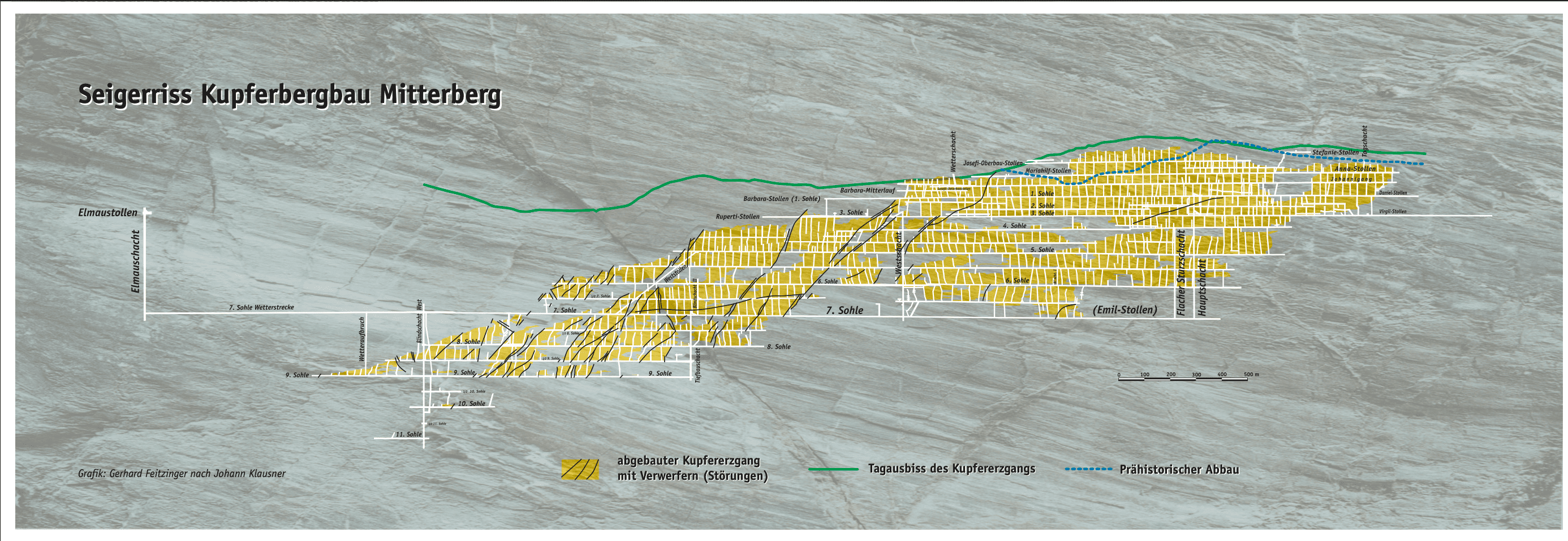Paussbauer - Mining in Mitterberg
Copper mining in the Mitterberg in
Mühlbach am Hochkönig was resumed
by the “Research Society of German
Copper Mining” after World War II. The
construction of stable and underground
shafts streamlined the production
conditions. In addition, the fl otation
systems were expanded with separate
chalcopyrite and pyrite concentrate
production. The problem was the lack of
a copper smelter. The ore concentrates
were fi rst delivered to Arnoldstein/
Carinthia and later – in times of falling
prices – to the copper processing company
Montanwerke in Brixlegg/Tyrol.
Development of copper prices led to
further streamlining in mining and
ore processing. With the reopening of
Westfeld in 1972, a clear streamlining of
the mining was achieved again. However,
another drop in prices in 1974 meant
that the company could no longer work
economically, so that ÖIAG shut down the
business on November 1, 1976. On average,
the mining company employed around 500
people, and in the end only 250. The total
ore reserves were still around 10 million
tons at the time of the closure.
Kids
Alpine drive and downforce
A cattle drive and an Alpine cattle drive are traditional events in the Alps that have to do with cows. In spring, when the snow melts and the meadows turn green, the farmers move their cows from the villages up to the mountain pastures. This is called "Almauftrieb". Up there on the lush mountain meadows, the cows can graze all summer long.
In autumn, when the summer is over and it gets colder, the farmers bring the cows back to the village. This is called the Almabtrieb. The cows often wear colourful garlands of flowers around their necks and sometimes even bells. This is a special day on which people celebrate that the cows have come back from the mountain pastures safe and sound.
Alpine drive and downforce
The Almauftrieb and Almabtrieb are old traditions in the mountains. During the cattle drive in spring, farmers take their cows from the villages up to the mountain pastures. Up there, the cows can graze throughout the summer.
During the cattle drive in autumn, the farmers bring the cows back to the village. The cows often wear floral decorations or colourful ribbons around their necks. Sometimes they also have large bells round their necks. The cattle drive is a special day when people come together to celebrate the cows returning from the mountain pastures to the valley healthy and well-fed.
Alpine drive and downforce
The cattle drive up and down the mountain pastures are important traditional events in the Alps that are associated with the management of mountain pastures and cows.
In spring, the farmers bring their cows from the farms to the higher alpine pastures. On the mountain pastures, they find lush green meadows where they can graze throughout the summer. This is important because there is often a lot of snow in the mountains in winter and the meadows only turn green again in spring.
The cattle drive in autumn marks the end of summer and the beginning of winter. The cows are brought back to the village from the mountain pastures. The cows also wear festive decorations during the cattle drive. They often have large bells around their necks. These traditions are not only important for agriculture, but also a reason for the communities to celebrate and come together.

